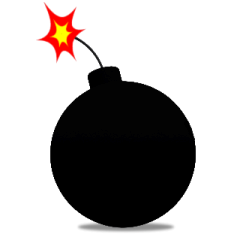By Barry Kavanagh, 17 October 2000
« Watchmen characters [warning: spoilers] | The Killing Joke and Brought to Light »
There are some interesting microcosms in Watchmen, like “the Black Freighter”. The protagonist asks “How had I reached this appalling position with love, only love as my guide?” whereas in the main story someone’s committed genocide in order to save the world.
Yeah, there’s even a bit where I think Adrian Veidt says at the end that he’s been “Troubled by dreams lately, of swimming towards – ” and then he says, “No, it doesn’t matter, it’s not important” and I mean it’s pretty obvious that he’s dreaming of swimming towards a great Black Freighter. Yeah, there’s a parallel there. The pirate narrative was again something that emerged by accident – it emerged by accident in issue #3 – and yet originally it just grew out of a kind of incidental comment made by me and Dave. We were trying to work out the texture of the world and so we sort of said “Well, what sort of comics would they have? If they’ve got superheroes in real life, they probably wouldn’t be at all interested in superhero comics” and I think Dave said “What about pirate comics?” and I said “Yeah, sounds good to me,” so we dropped a few pirate comic titles into the background, including “Tales of the Black Freighter” because I’m a big Brecht fan.
The Threepenny Opera?
Yeah, Pirate Jenny. So there was that particular point in issue #3 when I’d suddenly got all these different things going on at once and it suddenly struck me that I could have the newsvendor talking; I could have someone screwing up a radiation symbol on a fallout shelter across the street; I could have what the kid, who’s sitting with his back to the electrical hydrant near the newsvendor’s pitch, is reading in his comic; and I could kind of get this weird shit going on between these different levels where they’re striking sparks of meaning off each other –
– Yeah, they’re all commenting on each other.
Yeah and I suddenly realized what a benefit it was having this pirate narrative embedded in the overall narrative I could refer to and use as a counterpoint. I mean yes, it eventually does end up being the story of Adrian Veidt but there’s points during the pirate narrative [where] it relates to Rorschach and his capture; it relates to the self-marooning of Dr Manhattan on Mars; it can be used as a counterpoint to all these different parts of the story and after I’d done that it’s kind of manifested in a lot of work since then. Not a lot of work that people have seen but a lot of work, I mean Big Numbers had got two or three microcosms involved in it.Lost Girls, which is going to be coming out next year –
– Finished, yeah?
It’s nearly finished, we’ve got about five chapters to do, about forty pages. But that’s got a microcosm in it, in that there is a pornographic book at the hotel that the action’s taking place in, which is called “the White Book” and which seems to have been drawn and written by a group of great artists and great writers, people like Beardsley, Egon Schiele, Oscar Wilde. It’s a book of pastiches but that, again, can be used to counterpoint the main narrative. So yeah, that was a trick that I became quite fond of.
There’s one thing I thought was – maybe it’s just me but in that issue #3 of Watchmen, there’s one panel that I thought was a microcosm for the whole work. It’s the first time we see the “Gordian Knot Lock Co” guy, because the whole thing, Veidt’s whole plan is basically the Gordian Knot, isn’t it?
Sort of, yeah.
To use force to evade something.
Well actually, I mean the thing was when I actually named the [company], I thought we needed a locksmith, Rorschach’s gone and busted these locks and we need a locksmith and I thought “What would be a good name for a locksmith? The Gordian Knot Lock Co., they’ll never undo this sucker!” and it was just a kind of throwaway joke. I think we actually had that “They’ll never undo this sucker” as the company slogan and then I started to realize that Veidt/Alexander fixation and of course, the story is a kind of knot.
Yeah but when that lockman first appears there’s a bit of what Janey Slater is saying above him and she’s saying “Some things, once they’re busted, they can’t ever be fixed,” so it’s kind of like Jon saying to Veidt at the end “Nothing ever ends.”
“Nothing ever ends,” yeah.
And also, Seymour reaching for the diary at the end.
Yeah and “It’s all in your hands.”
Well, that one panel kind of has –
– Oh, I guess. Well the thing is, with Watchmen, what we tried to do was give it a truly kind of crystalline structure, where it’s like this kind of jewel with hundreds and hundreds of facets and almost each of the facets is commenting on all of the other facets and you can kind of look at the jewel through any of the facets and still get a coherent reading. Yeah, basically, there are single panels there, single images, that somehow kind of tie up the whole book.
Yeah, I’m sure next time I read it I’ll see some other things.
My daughter quite enjoyed [it]. I mean, it’s tailor-made for a university class, because there are so many levels and little background details and clever little connections and references in it that it’s one that academics can pick over for years.
One thing I found really funny is near the end there’s a little poster for a Tarkovsky season and the two films are Nostalgia and The Sacrifice. I think that’s quite funny.
Yeah, we just thought they’re going to be showing Russian directors, now that it’s post-reconciliation.
The two titles are so apt.
Yeah, well Nostalgia, because we’d been using that [word] all the way through. I think when we just got to the end we thought “Right. What are they showing at this cinema where they’ve previously been showing ’50s American disaster films?” and we thought “Alright, now they’re showing Russian films.” I think it was Dave who suggested Tarkovsky and said “Look, you know, there’s this film, Nostalgia…and The Sacrifice.” A lot of this stuff just dropped into our lap. I mean, we didn’t know that there was a smiley face on Mars. We discovered halfway through that there was a crater on Mars that looked like a giant smiley face. And when we set out to do it, we didn’t realize that about a month after Watchmen [would] come out, then the Tower Commission Report into Iran-Contragate would come out and use the Juvenal quote “Quis custodiet ipsos custodes” as its epigram. It was a bit weird, that Watchmen period, it all got a bit spooky, there were big coincidences happening around the work and then all of a sudden the central image of it has been nicked on all these acid house t-shirts everywhere, so something that was just in me and Dave’s head is now surrounding us in the culture and it felt a bit strange.
« Watchmen characters [warning: spoilers] | The Killing Joke and Brought to Light »

